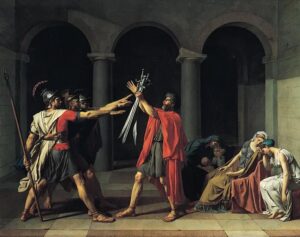
“There was no one near to confuse me, so I was forced to become original” – Joseph Haydn.
Close your eyes. Come on a quick journey with me. I’ll show you what the stars you look up to today inspired around 400 years ago. Let’s unravel the profundity that is Europe in the 17th century.
Visualize a period of great crisis. One so great it sparked the minds of cultural, demographic, economic, intellectual, political, and social historians alike. Revolts were breaking out in France, England, and the Spanish Empires. We are in a timeline in which a single crisis has affected this entire continent to some degree. Most countries had a noticeable decline in the economy, demography, and political stability.
We are often consumed by what we consume. The cloud that was this crisis did have a glistening silver lining: it led to the vivification of two new styles of art. These were the Baroque and Neoclassicism styles. Let’s dissect every intricacy and truly appreciate these masterpieces!
I’m sure most of you are familiar with the ‘Renaissance’ period. It was dramatic, radical, and nothing short of revolutionary. The Baroque style of art rose from the ashes of the omnipresent religious tensions and the looming threat of the Great Crisis. And it was truly something—it broke out of the ‘forced’ nature of Mannerism characteristic of the Renaissance era. The Baroque style of art implemented less idealistic and theological themes—it was crafted to appeal to the merchant and middle classes. It originated in Italy and spread to the rest of Europe.
Rather than limiting these masterpieces by mere definition, I shall give you a panoramic insight into their true character. Bernini’s ‘David’ has stark differences from Michelangelo’s ‘David’. Behold, I’ll transport you to this dimension.
This man’s eyes reflect wrath, concentration, grit, and power. He is about to slay Goliath—this iconic moment has been frozen in time. There is tangible emotional intensity in this sculpture. The movement is particularly inspired—the position has been recreated, paying great attention to fine details; every muscle, line, and wrinkle is crafted to perfection. It’s very real and imperfect, it has bumps and interrupted contours, but these only add to the beauty of it. The overall aim is as the artist desired—to take us back in time to the moment he visualized.
I’m slowly pulling you into this endless ocean, but alas, our time is short.
Slowly, we’ll scratch the surface of a Baroque painting I particularly love- ‘The Night Watch’ by Rembrandt van Rijn (1642).
Currently nestled in the Rijksmuseum in Amsterdam, this oil on canvas composition was created in the Dutch Golden Age. The proficient use of light and shadows demonstrates a technique called ‘tenebrism’. This picture focuses on the two men strolling in front and the old woman in the background. Because of the massive flag in the background, the characters appear life-sized. The insignia of the infantrymen have been portrayed effortlessly. It is speculated that the lady symbolizes a mascot bearing hidden emblems. The interpretation of these… let’s leave that up to your imagination, shall we?
Hold on, there’s a little more behind the curtain. I aim to change your perspective. Neoclassicism was resurrected from Classicism: Ancient Greek and Roman Art were again in vogue, with the Enlightenment movement taking the spotlight away from the themes of sensuality and aristocracy. The Greeks and Romans were respected for their democracy, and the citizens wanted to imbibe that spirit in their current political situation.
We have been now transported to the era of Neoclassicism—quintessentially showcasing heroic figures, subdued colours, strong lines, and a very central perspective. It is an unforgivable oversight if I dive into the Neoclassicism era without mentioning the pioneer—Jacques-Louis David.
‘The Oath of Horatii’ is probably the pinnacle of this period. David wants us to focus on the significance of the story behind the figures. He has used almost invisible brush strokes, in contrast to the wispy strokes of his predecessors. The intention is to keep our eyes glued to the subject matter. It depicts a scene from a Roman legend—the war between Alba Longa and Rome. Each city sent three men to fight, with victory determined by this singular battle. The Horatii family stood tall—the arms of three sons were raised in allegiance to their father. The convergence of the three swords adds depth and contrast to the painting; it evokes the spirit of solidarity, sacrifice, duty and loyalty in us. The darker background and highlighted foreground creates a sombre resolution in this dramatic scene—a refreshing and exhilarating contrast.
This painting went on to become a symbol of the French Revolution. It depicted a morally uplifting story and promoted the importance of civic duty.
The beauty of art is that “One must ease the public into it, that’s the art itself”. I just gave you a very brief overview, trying to follow this quote myself. I hope this article excites you, and compels you to see beyond the perception of your eyes. Our journey ends, and we stand, just a little more enlightened.
Written by Dhriti Bharadwaj for MTTN
Edited by Saurav Das for MTTN
Featured artwork and sculptures by Jacques-Louis David, Gian Lorenzo Bernini and Rembrandt Harmenszoon van Rijn.



Leave a Reply
You must be logged in to post a comment.